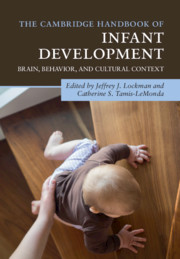Book contents
- The Cambridge Handbook of Infant Development
- The Cambridge Handbook of Infant Development
- Copyright page
- Dedication
- Contents
- Illustrations
- Contributors
- Preface
- Part I Foundations
- 1 Embodied Brain Model for Understanding Functional Neural Development of Fetuses and Infants
- 2 Infant Physical Growth
- 3 Dynamic Epigenetic Impact of the Environment on the Developing Brain
- 4 Brain Development in Infants
- 5 Development During Infancy in Children Later Diagnosed with Autism Spectrum Disorder
- Part II Perceptual Development
- Part III Cognitive Development
- Part IV Action
- Part V Language
- Part VI Emotional and Social Development
- Index
- References
2 - Infant Physical Growth
from Part I - Foundations
Published online by Cambridge University Press: 26 September 2020
- The Cambridge Handbook of Infant Development
- The Cambridge Handbook of Infant Development
- Copyright page
- Dedication
- Contents
- Illustrations
- Contributors
- Preface
- Part I Foundations
- 1 Embodied Brain Model for Understanding Functional Neural Development of Fetuses and Infants
- 2 Infant Physical Growth
- 3 Dynamic Epigenetic Impact of the Environment on the Developing Brain
- 4 Brain Development in Infants
- 5 Development During Infancy in Children Later Diagnosed with Autism Spectrum Disorder
- Part II Perceptual Development
- Part III Cognitive Development
- Part IV Action
- Part V Language
- Part VI Emotional and Social Development
- Index
- References
Summary
Physical growth is a fundamental feature of an infant’s first year, evident as the average neonate triples their weight and becomes 50% taller, rapidly outgrowing clothing while uttering their first words, enduring eruption of their first teeth, and taking their first steps. This remarkable transition in form continues a journey that began roughly 270 days earlier (Jukic, Baird, Weinberg, McConnaughey, & Wilcox, 2013) when a 0.5 micron fertilized egg cell initiated a series of differentiation, proliferation, and expansion events. Within days of consolidating the genetic material from maternal and paternal germ cells, the new zygotic genome becomes activated (Braude, Bolton, & Moore, 1988), replacing a sole reliance on proteins from the mother’s egg and reproductive tract. The first cell undergoes successive mitotic cycles resulting in cell proliferation within the original membrane formed by the fusion of the sperm and egg. By the end of the first week, the contiguous mass of new cells is compressed by the emergence of a fluid-filled cavity, creating an inner cell mass within the membrane.
Keywords
- Type
- Chapter
- Information
- The Cambridge Handbook of Infant DevelopmentBrain, Behavior, and Cultural Context, pp. 40 - 69Publisher: Cambridge University PressPrint publication year: 2020



